History of Nova Scotia - Acadiens in New France (l'Acadie, Nova Scotia)
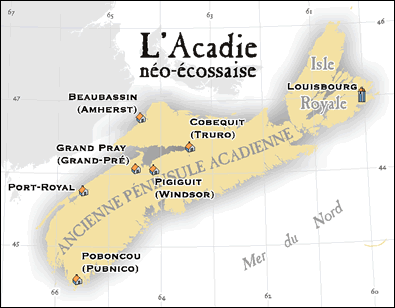
|
Illustration: L'Acadie |
|
| Click here for a full size image | ||
Contents
1) 1603 - French l'Acadie2) The French and Indian Wars
3) 1654 - British Attack on French l'Acadie (Cromwell)
4) 1667 - Treaty of Breda (French Control until 1713)
5) 1702-13 Queen Anne's War (
6) 1713-40 Twenty Three Years of Peace
7) 1740-48 King George’s War
8) 1750 - 1754 Tensions build that lead to the French and Indian War
9) 1753 - Charles Lawrence becomes Lieutenant Governor
10) Principle Acadian Districts 1755
1603 - French l'Acadie
Nova Scotia, also known as l'Acadie, was the first European colony in North America.
Beginning in 1603 during the reign of King Henri IV, French began the systematic settlement of l'Acadie, Nova Scotia. During the centruy that followed it was plagued as being a pivot betwween the world powers of France and England.
The first attempt by England to supplant a settlement came in 1621 by King James I who granted a charter to Sir William Alexander to settle New Scotland (Nova Scotia). After devastating attempts to move settlers there, England returned Nova Scotia to French control in 1631.
Charles La Tour had become governor of Acadia in 1631. His fort was buit at the mouth of the St. John River in 1635.
Isaac de Razilly, cousin of Cardnial Richelieu, was sent by his cousin to Port-Royal with the title Lieutenant-general of all of New France and governor of Acadia in 1631. Charles de Menou d'Aulnay and Nicolas Denys came with Razilly and would be credited as significant developers of the region. Upon his arrival in Nova Scotia, Razilly entered an agreement with La Tour whereby control of Acadia was divided. La Tour took control of the south-western corner of Nova Scotia and the territory along the Saint John River and Razilly took control of the eastern territory of Nova Scotia.
Baron Philippe Mius d’Entremont was sent to Cap-de-Sable in 1651 to settle the area. In 1670 Philippe Mius d’Entremont was appointed lieutenant-major and commander of the king’s troops, and appointed the King's Attorney General, (procureur du roi).
Charles La Tour had become governor of Acadia in 1631. His fort was buit at the mouth of the St. John River in 1635.
The French and Indian Wars
The early colonial wars between France and Britain were fought primarily in Europe. Both empires had an interest in the colonization of North America and conflicts frequently arose as a result of territorial claims.
By the late 17th century, a great rivalry had developed between France and Britain. Over a period of roughly 70 years, four major wars would be fought between these powers. As time passed, the importance of colonies, North America in particular, grew in importance. The final round in this struggle, The French and Indian War, resulted in the end of New France.
Note: Each link in the chart below will bring you to the corresponding Wikipedia page
The North American wars, and their associated European wars, in sequence, are:
| Years of War | North American War | European War | Treaty |
|---|---|---|---|
| 1689 – 1697 |
King William's War |
War of the Grand Alliance War of the League of Augsburg |
Treaty of Ryswick |
| 1702 – 1713 |
Queen Anne's War |
War of the Spanish Succession | Treaty of Utrecht (1713) |
| 1724 – 1725 | Dummer's War | Dummer's Treaty of December 15, 1725 | |
| 1744 – 1748 |
King George's War |
War of Jenkins' Ear War of the Austrian Succession |
Treaty of Aix-la-Chapelle (1748) |
| 1754 – 1763 |
The French and Indian War |
Seven Years' War | Treaty of Paris (1763) |
The above information and chart can be referenced at The French and Indian Wars Wikipedia page.
1654 - British Attack on French l'Acadie (Cromwell)
During the conflict for power that erupted between King Charles I and Oliver Cromwell, in 1651 Parliament passed a Navigation Act. The Navigation Act was aimed at the Dutch and mandated that goods from North America be carried only on English ships. The act ignited a war between the Dutch and England in which the French becaome allied with the Dutch.
In 1654, a force of soldiers from Boston under the command of Robert Sedgewick attacked the fort of Port Royal during a campaign initiated due to Oliver Cromwell's orders to clear Nova Scotia of the French. With the French surrender in Nova Scotia as a result of Sedgewick's victories, all French military personnel were sent back to France. In 1655, Cromwell sent Sir Thomas Temple to l'Acadie with the title of Governor. It is believed that it was during this voyage with Sir Thomas Temple that Pierre dit LaVerdure, his wife Priscilla, and their sons, Pierre, Charles and Jean arrived in l'Acadie.
1667 - Treaty of Breda (French Control until 1713)
England maintained control of l'Acadie until the Treaty of Breda was signed on July 31, 1667, returning l'Acadie to France. France took control of l"Acadie in 1670 and maintained control until events occurring in Europe brought on another war between France and England, in 1702, known as Queen Anne's war.
1702-13 Queen Anne's War (British Control)
During the fighting that commenced in Queen Anne's War, British forces under Francis Nicholson captured Port Royal in French l'Acadie in 1710. After the fall of Port Royal, it was renamed "Annapolis Royal" in honor of the English queen. A British naval attack against Quebec, however, was not successful. The war ended with British victory and on 11 April 1713 "The Peace of Utrecht" was signed. In this treaty France ceded Maritime provinces to Britain. The French colony of l'Acadie, now Nova Scotia, was ceded to Great Britain.
The British, nervous about the loyalties of the French-speaking inhabitants of the newly created colony of Nova Scotia, demanded that the Acadians swear an oath of loyalty to the British. The Acadians offered to swear their neutrality. In 1730, the British agreed and the Acadians became the "French Neutrals."
1713-1740 Twenty Three Years of Peace
1740-1748 King George’s War
King George’s War, 1740-1748, brought the terms and conditions of the Treaty of Utrecht to a close. King George's War is also known as (War of Austrian Succession and led to the French and Indian War (1754-63).
Governor Cornwallis asked the Acadians to take an oath of allegiance to the King of England in 1749. Although they refused, Cornwallis did not force an agreement. Peregrine Hopson followed Cornwallis as governor and continued with the policy of appeasement that had been previously set in place for the Acadians.
1750-1754 Tensions build - French and Indian War #4
The English were in control of Acadia when the war began. The Acadians were French in language and customs. The English feared that French priests would persuade the Acadians and Indians to enter the war.
England were concerned that the Acadians would join arms with the French and attempted to mandate that the Acadians (French Neutrals), commit to an oath of allegiance to the Crown.
1753 Charles Lawrence becomes Lieutenant Governor of Nova Scotia
British military officer, Charles Lawrence was promoted to Major in the 45th Regiment at Louisbourg in 1747. He became Lieutenant Governor of Nova Scotia in 1753 and took part in the battle against the French presence in Nova Scotia by ordering an attack on Fort Beauséjour in June 1755.
Principle Acadian Districts 1755:
Bay of Fundy / Port Royal Settlements (Charles Mellanson dit L'Ramee),
and Chignecto Region
source: John Mack Faragher, A Great and Noble Scheme: The Tragic Story of the Expulsion of the French Acadians from their American Homeland (New York: W.W. Norton & Company, 2005), xxvi-xxvii.
Grand Pré (Minas Basin) and Melanson (Port Royal) Settlements Highlighted in Yellow
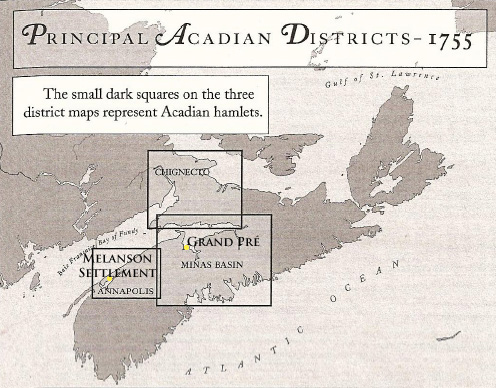
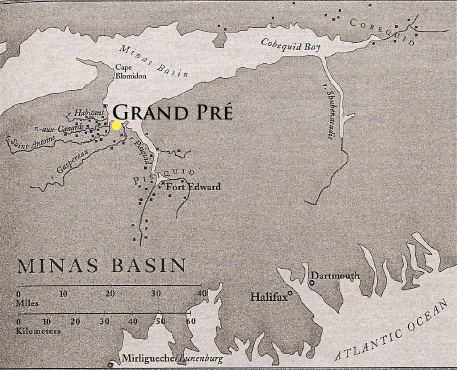
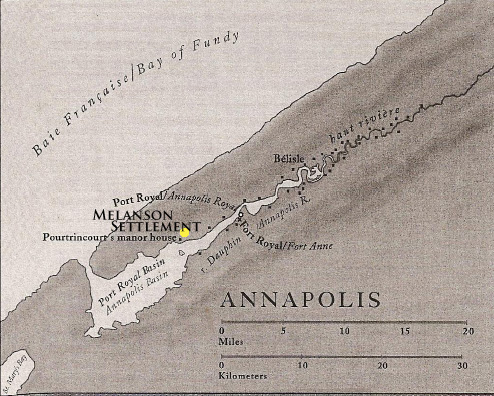
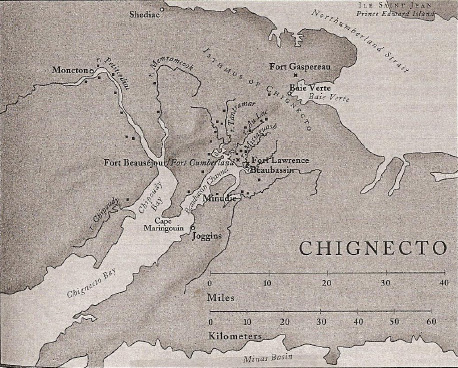
 yahoo.com
yahoo.com